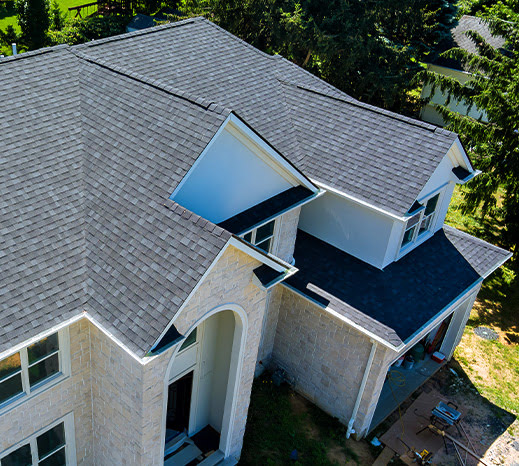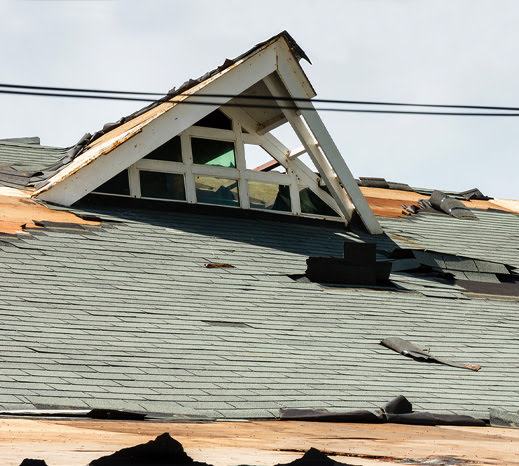A solid roof is an important part of keeping your home warm, dry, and cozy. However, a leaky roof can cause more than just a headache: It can create a...

Your Shingles Are Curling or Cracked
 There are two ways shingles can curl: Clawing occurs when the center of your shingles bulge upwards, and cupping occurs when the corners of your shingles curl upwards. Both clawing and cupping shingles indicate that a leak, or many leaks, may be on the horizon. Depending on how many shingles are affected and how curled they are you may have between one and five years of life left in your roof.
Shingles typically crack due to wind damage. If just a few shingles are cracked you can easily keep more serious problems at bay by simply replacing the affected shingles, but if the cracking is widespread, and isn’t isolated to one area, then you should consider planning to replace your roof. Depending on the extent of the cracking your roof may have between three and five years of life left.
There are two ways shingles can curl: Clawing occurs when the center of your shingles bulge upwards, and cupping occurs when the corners of your shingles curl upwards. Both clawing and cupping shingles indicate that a leak, or many leaks, may be on the horizon. Depending on how many shingles are affected and how curled they are you may have between one and five years of life left in your roof.
Shingles typically crack due to wind damage. If just a few shingles are cracked you can easily keep more serious problems at bay by simply replacing the affected shingles, but if the cracking is widespread, and isn’t isolated to one area, then you should consider planning to replace your roof. Depending on the extent of the cracking your roof may have between three and five years of life left.
Shingles Are Missing
 If you are only missing a couple of shingles then you may not need to replace your entire roof. However, if you choose to patch your roof you should know that the new shingles will probably not match the old ones. Granular colors change over the years depending on current tastes, and your roof’s color will also fade over time.
Depending on how many shingles you are missing, and whether or not the problem is recurring, it may not be worth the cost and headache to keep patching your roof until a bigger issue arises. If your roof is starting to look a little to checkerboard-like you may want to start planning a total replacement.
If you are only missing a couple of shingles then you may not need to replace your entire roof. However, if you choose to patch your roof you should know that the new shingles will probably not match the old ones. Granular colors change over the years depending on current tastes, and your roof’s color will also fade over time.
Depending on how many shingles you are missing, and whether or not the problem is recurring, it may not be worth the cost and headache to keep patching your roof until a bigger issue arises. If your roof is starting to look a little to checkerboard-like you may want to start planning a total replacement.
There Are Granules in Your Gutters
 If you’ve just had a new roof installed and there are a few granules in your gutters you shouldn’t be concerned. Those granules are simply extra ones that got stuck to your shingles and are now coming loose. However, if your roof is more than ten years old and you are still finding granules in your gutter you may want to investigate further.
Granules help to shade the asphalt in your roof. If too many granules fall off your shingles will start to bake, which can cause them to deteriorate far more quickly then they should. Your shingles typically start to shed granules about halfway through the lifespan of your roof, so while this doesn’t indicate a time sensitive problem you may want to start planning to replace your roof relatively soon.
If you’ve just had a new roof installed and there are a few granules in your gutters you shouldn’t be concerned. Those granules are simply extra ones that got stuck to your shingles and are now coming loose. However, if your roof is more than ten years old and you are still finding granules in your gutter you may want to investigate further.
Granules help to shade the asphalt in your roof. If too many granules fall off your shingles will start to bake, which can cause them to deteriorate far more quickly then they should. Your shingles typically start to shed granules about halfway through the lifespan of your roof, so while this doesn’t indicate a time sensitive problem you may want to start planning to replace your roof relatively soon.
You Have a Moss or Algae Problem
 Moss and algae are unsightly but harmless. Most individuals with a moss or algae problem opt to replace their roof for purely cosmetic reasons. You may be tempted to try and remove the algae or moss yourself, but you should be careful. If you try and scrape or pressure wash the growth away you may end up damaging your roof. Scraping and power washing removes granules, which drastically shortens the lifespan of your roof.
Moss and algae are unsightly but harmless. Most individuals with a moss or algae problem opt to replace their roof for purely cosmetic reasons. You may be tempted to try and remove the algae or moss yourself, but you should be careful. If you try and scrape or pressure wash the growth away you may end up damaging your roof. Scraping and power washing removes granules, which drastically shortens the lifespan of your roof.
There Are Sunbeams in Your Attic
If sunlight is getting through your roof it isn’t a good sign. If light can get in then so can wind, rain, and snow. Each spring, after the snow melts, you should go up to the attic and check for sunlight. If you see any sunbeams peeking through you should also check for nearby water damage. If you find any you may have an active leak. Take a photo of the water damage and then come back in a couple of days and compare the photo to the damage. If the damaged spots look bigger it likely means you have a leak. Leaks need to be dealt with as soon as possible before they get out of hand and cause more damage. Depending on how extensive the damage is you may need to call in a professional for help. Small leaks can be patched, but if you have a large leak, structural damage, or an old roof it will likely be more cost effective in the long run to replace your roof sooner rather than later.Your Roof is Sagging
 A sagging roof is a cause for alarm and may indicate larger structural damage. A sagging roof may mean there is a problem with your attic’s decking, or even that there is a problem with the supports in your foundation.
While you and your family are likely not in any immediate danger you should still get your roof problems addressed as soon as possible. Serious problems like these are easier (and more cost-effective) to take care of when they are small or localized. While some repairs around your home can be tackled with a DIY attitude, extensive problems like a sagging roof require a professional touch.
A sagging roof is a cause for alarm and may indicate larger structural damage. A sagging roof may mean there is a problem with your attic’s decking, or even that there is a problem with the supports in your foundation.
While you and your family are likely not in any immediate danger you should still get your roof problems addressed as soon as possible. Serious problems like these are easier (and more cost-effective) to take care of when they are small or localized. While some repairs around your home can be tackled with a DIY attitude, extensive problems like a sagging roof require a professional touch.
Your Roof is More than 20 Years Old
 Asphalt shingle roofs typically last between twenty and thirty years, so as the twenty-year mark approaches you should consider planning your roof replacement. Even if your roof has another decade of life left it never hurts to plan ahead and be prepared.
You don’t want to wait until something goes wrong before you start considering replacing your roof. As part of your spring cleaning checklist you schedule an annual roof inspection with a professional, and keep an eye on your roof between inspections so that you can catch problems early on and address them before they become too serious.
Asphalt shingle roofs typically last between twenty and thirty years, so as the twenty-year mark approaches you should consider planning your roof replacement. Even if your roof has another decade of life left it never hurts to plan ahead and be prepared.
You don’t want to wait until something goes wrong before you start considering replacing your roof. As part of your spring cleaning checklist you schedule an annual roof inspection with a professional, and keep an eye on your roof between inspections so that you can catch problems early on and address them before they become too serious.


